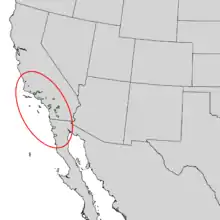| Ceanothus spinosus | |
|---|---|
 | |
| Scientific classification | |
| Kingdom: | Plantae |
| Clade: | Tracheophytes |
| Clade: | Angiosperms |
| Clade: | Eudicots |
| Clade: | Rosids |
| Order: | Rosales |
| Family: | Rhamnaceae |
| Genus: | Ceanothus |
| Species: | C. spinosus |
| Binomial name | |
| Ceanothus spinosus | |
 | |
| Natural range of Ceanothus spinosus in California chaparral and woodlands habitats. | |
Ceanothus spinosus, with the common names greenbark and redheart, is a species of Ceanothus.[1] It is native to southern California and northern Baja California, where it grows in the scrub and chaparral of the coastal mountain ranges.
Range and habitat
Growth pattern
Ceanothus spinosus is a large treelike shrub approaching 6 metres (20 ft) in maximum height.[1]
Leaves and stems
Leaves have a single main vein rising from the leaf base.[1] The thick, firm evergreen leaves are hairless, oval, and up to an inch wide, with smooth margins.[1]
The bark is smooth and olive green, giving rise to its common name.[1] The stem is a rough-barked trunk near the base. Branches are stiff and sharp, or spiny, at the tips.[1] "Ceanothus" means "spiny plant" in Greek, and the species name, "spinosus", means that it is even more spiny.[1]
The stipules (small leaf-like structures at the base of the leaf stem) are thin and fall off early.[1]
Inflorescence and fruit
The shrub blooms in inflorescences up to 15 centimeters long filled with clusters of white to pale blue flowers.[1] The fruit is a smooth, round capsule about half a centimeter wide containing three lobes.
Fruits do not have horns, as do some other members of the genus.[1]
It blooms from February to May.[1]